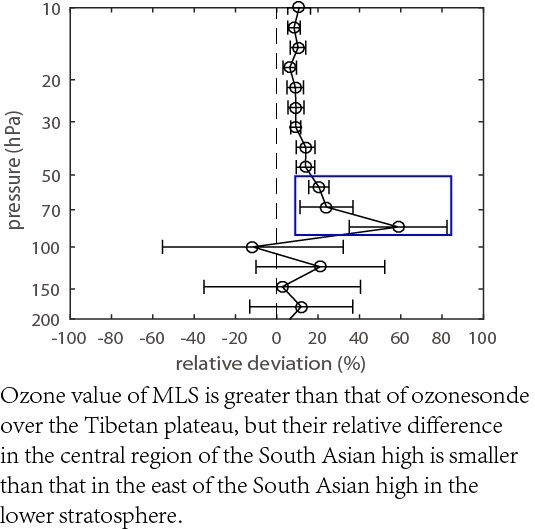Comparison of Electrochemical Concentration Cell Ozonesonde and Microwave Limb Sounder Satellite Remote Sensing Ozone Profiles for the Center of the South Asian High
Abstract
:1. Introduction
2. Materials and Methods
2.1. Ozonesonde Data
2.2. MLS Ozone Products
2.3. ERA-Interim Dataset
2.4. Methods
3. Results
3.1. Comparison of Ozone Profiles between the Two Datasets
3.2. Linear Regression Analysis between MLS and Ozonesonde Data
4. Discussion
5. Conclusions
Acknowledgments
Author Contributions
Conflicts of Interest
References
- Bian, J.C.; Yan, R.C.; Chen, H.B.; Lu, D.R.; Massie, S.T. Formation of the summertime ozone valley over the Tibetan Plateau: The Asian summer monsoon and air column variations. Adv. Atmos. Sci. 2011, 28, 1318–1325. [Google Scholar] [CrossRef]
- Guo, D.; Wang, P.X.; Zhou, X.J.; Liu, Y.; Li, W.L. The dynamic effects of the South Asian high on the ozone valley over the Tibetan Plateau. Acta Meteorol. Sin. 2012, 26, 216–228. [Google Scholar] [CrossRef]
- Guo, D.; Su, Y.C.; Shi, C.H.; Xu, J.J.; Alfred, M.P., Jr. Double Core of Ozone Valley over the Tibetan Plateau and its Possible Mechanisms. J. Atmos. Terr. Phys. 2015, 130–131, 127–131. [Google Scholar] [CrossRef]
- Guo, D.; Su, Y.C.; Zhou, X.J.; Xu, J.J.; Shi, C.H.; Liu, Y.; Li, W.L.; Li, Z.K. Evaluation of Trend Uncertainty of Summer Ozone Valley over Tibetan Plateau in Three Reanalysis Datasets. J. Meteorol. Res. 2017, 31, 431–437. [Google Scholar] [CrossRef]
- Li, Z.K.; Qin, H.; Guo, D.; Zhou, S.W.; Huang, Y.; Su, Y.C.; Wang, L.W.; Sun, Y. Impact of Ozone Valley over the Tibetan on South Asian High in CAM5. Adv. Meteorol. 2017. [Google Scholar] [CrossRef]
- Zhou, X.; Luo, C.; Li, W.L.; Shi, J.E. Variation of Total Ozone in China and Low—Value Center of Qinghai—Tibet Plateau. Sci. Bull. 1995, 40, 1396–1398. [Google Scholar]
- Russell, J.M., III; Gordley, L.L.; Park, J.H.; Drayson, S.R.; Hesketh, W.D.; Cicerone, R.J.; Tuck, A.F.; Frederick, J.E.; Harries, J.E.; Crutzen, P.J. The Halogen Occultation Experiment. J. Geophys. Res. Atmos. 1993, 98, 10777–10797. [Google Scholar] [CrossRef]
- Mauldin, L.E.; Zaun, N.H.; McCormick, M.P.; Guy, J.H.; Vaughn, W.R. Stratospheric Aerosol and Gas Experiment II Instrument: A Functional Description. Opt. Eng. 1985, 24, 242307. [Google Scholar] [CrossRef]
- Waters, J.W.; Froidevaux, L.; Harwood, R.S.; Jarnot, R.F.; Pickett, H.M. The Earth observing system microwave limb sounder (EOS MLS) on the aura Satellite. IEEE Trans. Geosci. Remote. Sens. 2006, 44, 1075–1092. [Google Scholar] [CrossRef]
- Jiang, Y.B.; Froidevaux, L.; Lambert, A.; Licesey, N.J.; Read, W.G.; Waters, J.W.; Bojkov, B.; Leblanc, T.; McDermid, I.S.; Godin-Beekmann, S.; et al. Validation of Aura Microwave Limb Sounder ozone by ozonesonde and lidar measurements. J. Geophys. Res. 2007, 112, 6033–6044. [Google Scholar] [CrossRef]
- Cai, Z.N.; Wang, Y.; Liu, X.; Zheng, X.D.; Chance, K.; Liu, Y. Validation of GOME ozone profiles and tropospheric column ozone with ozone sonde over China. J. Appl. Meteorol. Sci. 2009, 20, 337–345. (In Chinese) [Google Scholar]
- Pan, L.; Niu, S.J. A Comparison of Total Column Ozone Values Derived from AIRS, TOVS and TOMS. J. Remote. Sens. 2008, 12, 54–63. [Google Scholar]
- Yan, X.L.; Wright, J.S.; Zheng, X.D.; Livesey, N.J.; Vömel, H.; Zhou, X.J. Validation of Aura MLS retrievals of temperature, water vapour and ozone in the upper troposphere and lower–middle stratosphere over the Tibetan Plateau during boreal summer. Atmos. Meas. Tech. 2016, 9, 3547–3566. [Google Scholar] [CrossRef]
- Yan, X.L.; Zheng, X.D.; Zhou, X.J.; Vömel, H.; Song, J.Y.; Li, W.; Ma, Y.H.; Zhang, Y. Validation of Aura Microwave Limb Sounder water vapor and ozone profiles over the Tibetan Plateau and its adjacent region during boreal summer. Sci. China Earth Sci. 2015, 58, 589–603. [Google Scholar] [CrossRef]
- Bian, J.C.; Pan, L.L.; Paulik, L.; Vömel, H.; Chen, H.B.; Lu, D. In situ water vapor and ozone measurements in Lhasa and Kunming during the Asian summer monsoon. Geophys. Res. Lett. 2012, 39, L19808. [Google Scholar] [CrossRef]
- Zhen, X.D.; Tang, J.; Li, W.L.; Zhou, X.J.; Shi, G.Y. Observational study on total ozone amout and its vertical profile over lhasa in the summer of 1998. Q. J. Appl. Meteorol. 2000, 11, 173–179. (In Chinese) [Google Scholar]
- Vetter, K.J. Electrochemical Kinetics-Theoretical and Experimental Aspects; Translated by Academic Press Inc.; Originally Published as “Electrochemische Kinetik”; Springer: Heidelberg/Berlin, Germany, 1967. [Google Scholar]
- Komhyr, W.D. Electrochemical concentration cells for gas analysis. Ann. Geophys. 1969, 25, 203–210. [Google Scholar]
- Smit, H.G.J.; Straeter, W.; Johnson, B.J.; Oltmans, S.J.; Davies, J.; Tarasick, D.W.; Hoegger, B.; Stubi, R.; Schmidlin, F.J.; Northam, T.; et al. Assessment of the performance of ECC-ozonesondes under quasi-flight conditions in the environmental simulation chamber: Insights from the Jülich Ozone Sonde Intercomparison Experiment (JOSIE). J. Geophys. Res. 2007, 112, D19306. [Google Scholar] [CrossRef]
- Komhyr, W.D.; Barnes, R.A.; Brothers, G.B.; Lathrop, J.A.; Opperman, D.P. Electrochemical concentration cell ozonesonde performance evaluation during STOIC 1989. J. Geophys. Res. 1995, 100, 9231–9244. [Google Scholar] [CrossRef]
- Livesey, N.J.; Read, W.G.; Wagner, P.A.; Froidevaux, L.; Lambert, A.; Manney, G.L.; Millán-Valle, L.F.; Pumphrey, H.C.; Santee, M.L.; Schwartz, M.J.; et al. Version 4.2x Level 2 Data Quality and Description Document; version 4.2x-1.0; Tech. Rep. JPL D-33509; NASA Jet Propulsion Laboratory: Pasadena, CA, USA, 2015.
- Witte, J.C.; Anne, M.; Thompson, A.M.; Smit, H.G.J.; Fujiwara, M.; Posny, F.; Coetzee, G.J.R.; Northam, E.T.; Johnson, B.J.; Sterling, C.W.; et al. First reprocessing of Southern Hemisphere ADditional OZonesondes (SHADOZ) profile records (1998–2015): 1. Methodology and evaluation. J. Geophys. Res. Atmos. 2017, 122, 6611–6636. [Google Scholar] [CrossRef]
- Dee, D.P.; Uppala, S.M.; Simmons, A.J.; Berrisford, P.; Poli, P.; Kobayashi, S.; Andrae, U.; Balmaseda, M.A.; Balsamo, G.; Bauer, P.; et al. The ERA-Interim reanalysis: Configuration and performance of the data assimilation system. Q. J. R. Meteorol. Soc. 2011, 137, 553–597. [Google Scholar] [CrossRef]
- Rodgers, C.D. Characterization and error analysis of profiles retrieved from remote sonde measurements. J. Geophys. Res. 1990, 95, 5587–5595. [Google Scholar] [CrossRef]
- Von Clarmann, T. Validation of remotely sensed profiles of atmospheric state variables: Strategies and terminology. Atmos. Chem. Phys. 2006, 6, 4311–4320. [Google Scholar] [CrossRef]
- Luo, J.L.; Song, J.Y.; Tian, H.Y.; Liu, L.; Liang, X.L. A Case Study of Mass Transport during the East-west Oscillation of the Asian Summer Monsoon Anticyclone. Adv. Meteorol. 2017, in press. [Google Scholar]
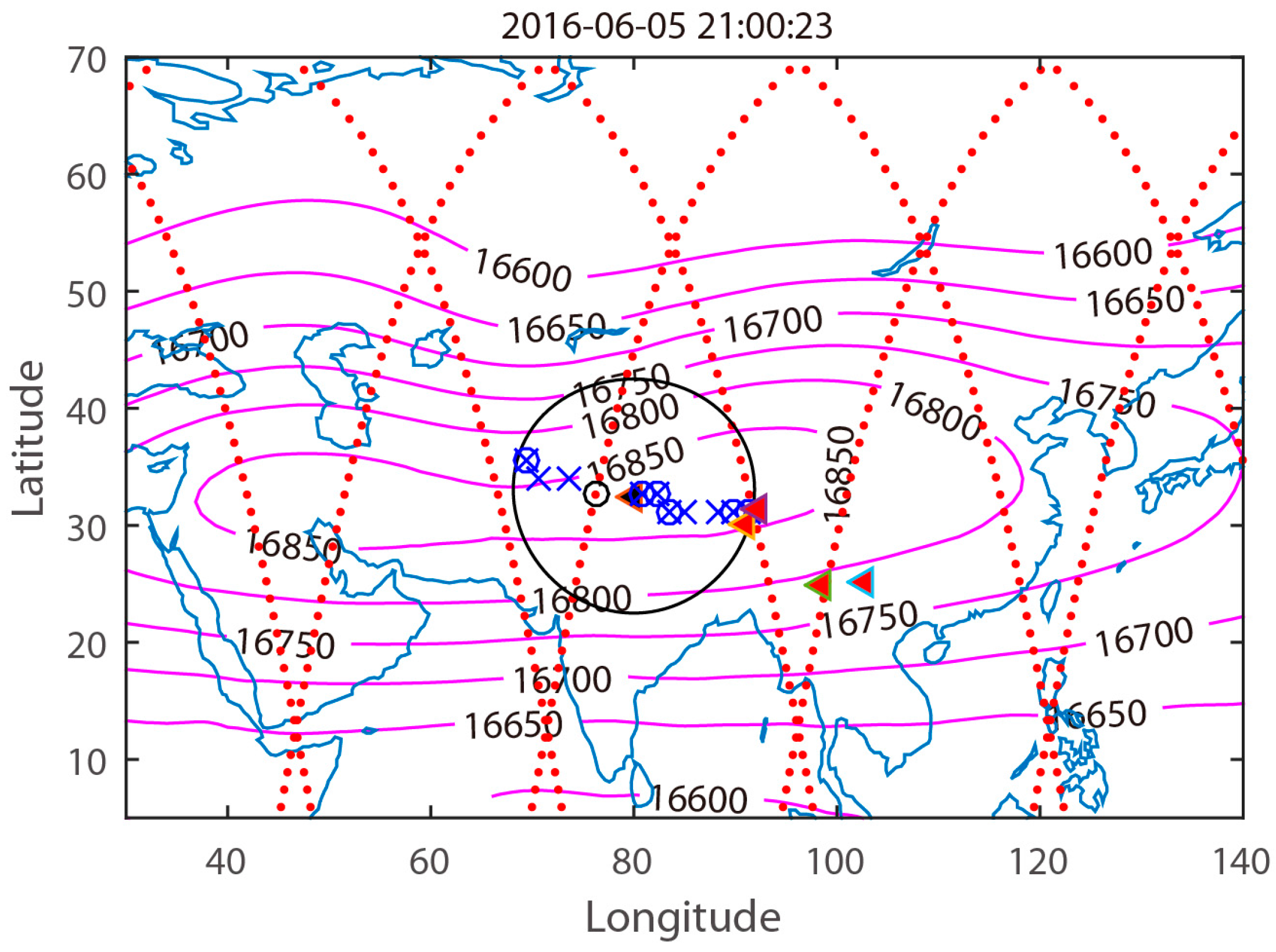
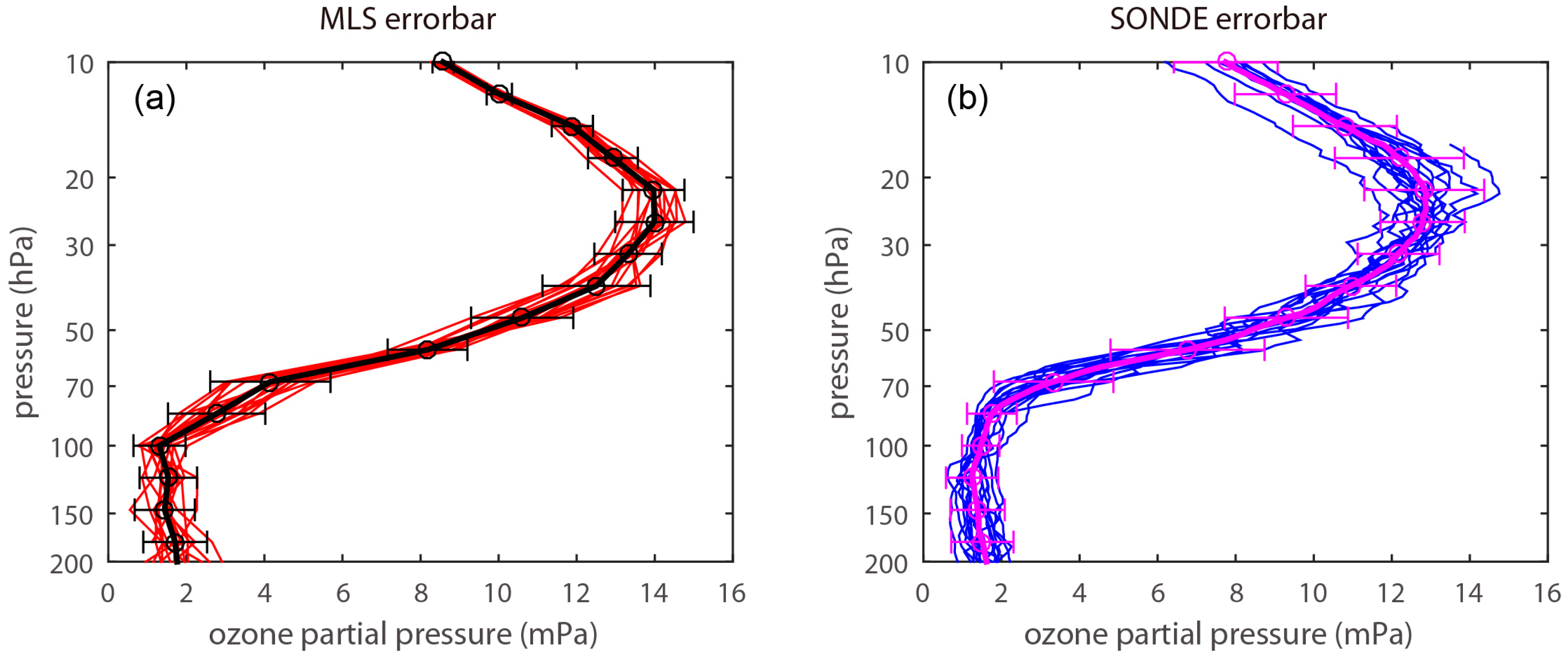

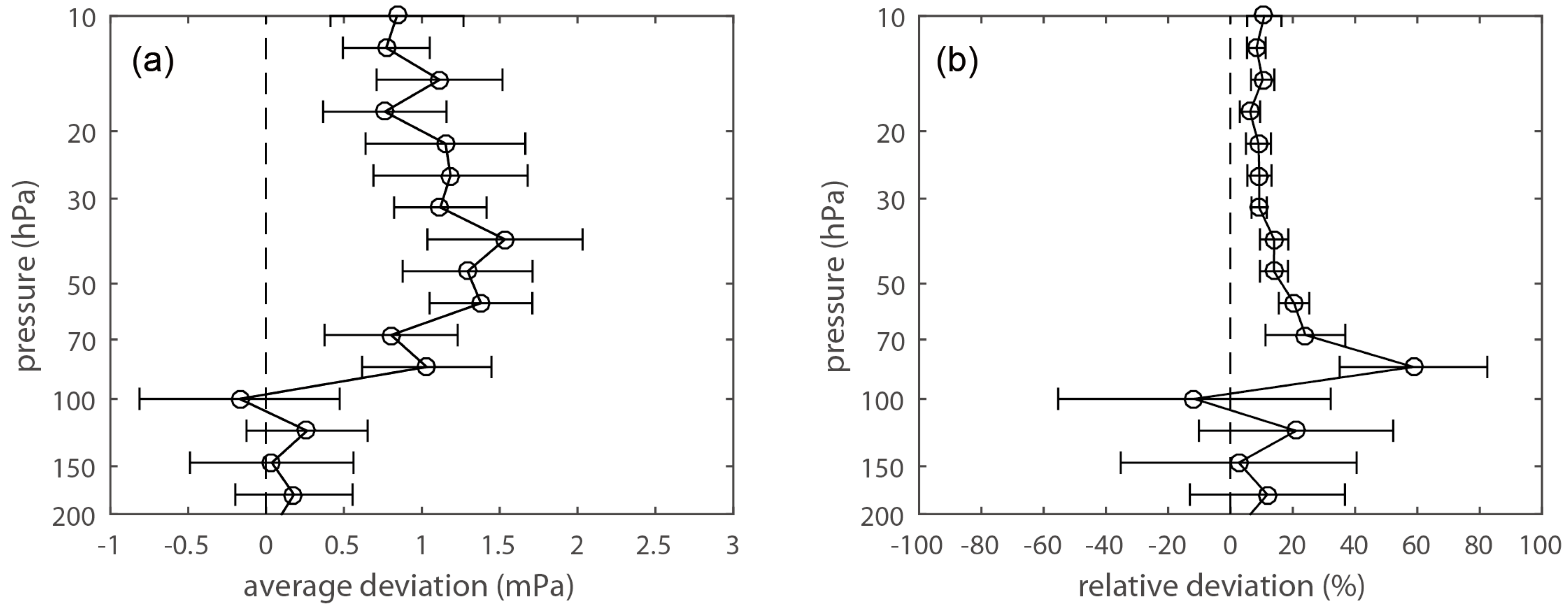
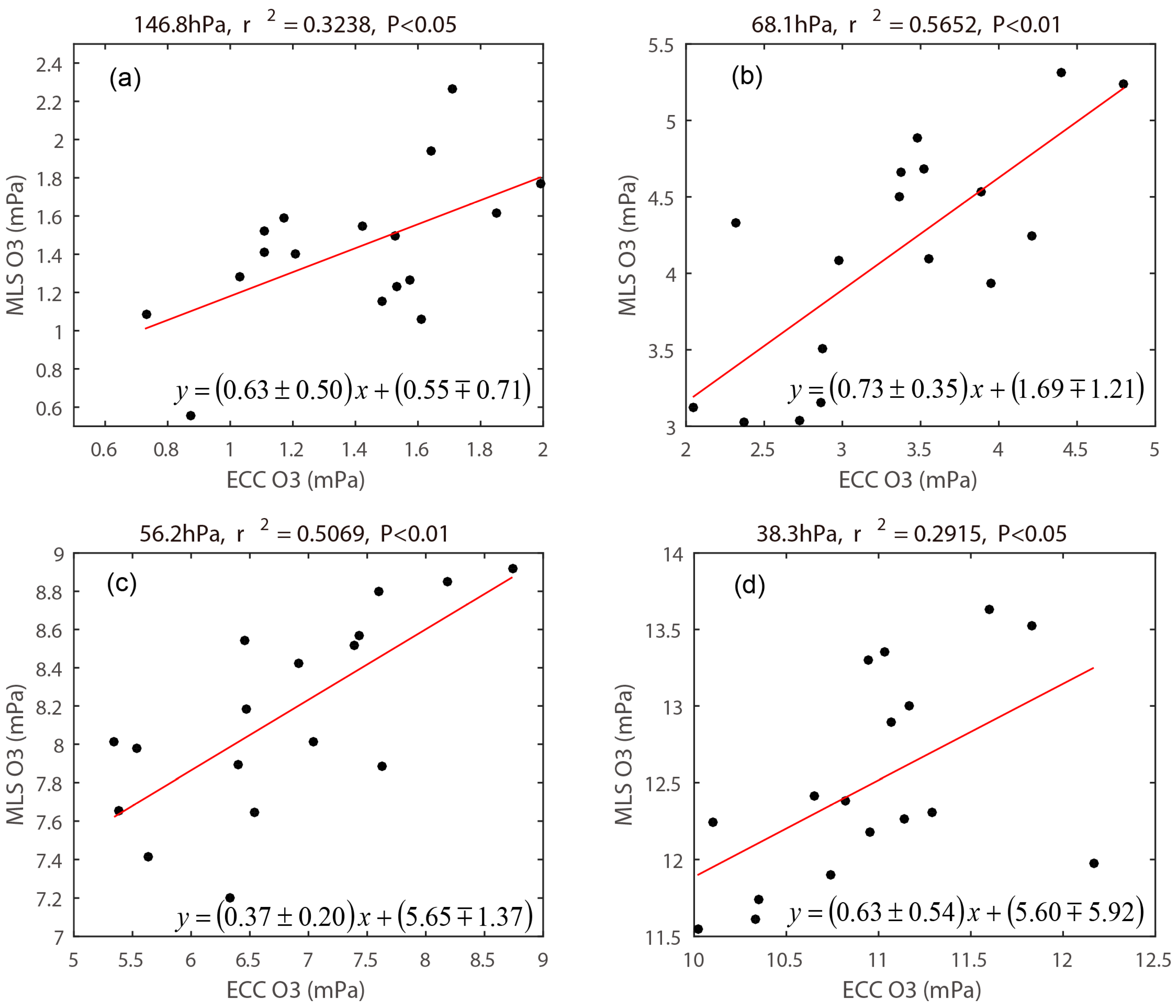
| Pressure (hPa) | Coefficient of Determination (r2) | Slope (β) | Intercept (α) | α/ (%) | (mPa) | Probability (p) |
|---|---|---|---|---|---|---|
| 215.4 | 0.03 | 0.43 | 1.04 | 61 | 1.7128 | 0.5186 |
| 177.8 | 0.01 | 0.05 | 1.61 | 106 | 1.5120 | 0.8391 |
| 146.8 | 0.32 | 0.63 | 0.55 | 40 | 1.3869 | 0.0171 |
| 121.2 | 0.10 | 0.34 | 1.08 | 87 | 1.2475 | 0.2285 |
| 100.0 | 0.01 | -0.09 | 1.44 | 98 | 1.4687 | 0.7923 |
| 82.5 | 0.14 | 0.72 | 1.52 | 87 | 1.7561 | 0.1333 |
| 68.1 | 0.57 | 0.73 | 1.69 | 51 | 3.3368 | 0.0005 |
| 56.2 | 0.51 | 0.37 | 5.65 | 83 | 6.7669 | 0.0013 |
| 46.4 | 0.16 | 0.32 | 7.58 | 82 | 9.2981 | 0.1102 |
| 38.3 | 0.29 | 0.63 | 5.60 | 51 | 10.9522 | 0.0253 |
| 31.6 | 0.10 | 0.27 | 10.06 | 83 | 12.1725 | 0.2070 |
| 26.1 | 0.01 | -0.10 | 15.21 | 119 | 12.7878 | 0.6855 |
| 21.5 | 0.01 | 0.04 | 13.48 | 105 | 12.8315 | 0.7674 |
| 17.8 | 0.04 | 0.08 | 12.04 | 99 | 12.1934 | 0.4673 |
| 14.7 | 0.04 | 0.08 | 11.05 | 102 | 10.8000 | 0.5173 |
| 12.1 | 0.01 | -0.01 | 10.05 | 108 | 9.2744 | 0.9840 |
© 2017 by the authors. Licensee MDPI, Basel, Switzerland. This article is an open access article distributed under the terms and conditions of the Creative Commons Attribution (CC BY) license (http://creativecommons.org/licenses/by/4.0/).
Share and Cite
Shi, C.; Zhang, C.; Guo, D. Comparison of Electrochemical Concentration Cell Ozonesonde and Microwave Limb Sounder Satellite Remote Sensing Ozone Profiles for the Center of the South Asian High. Remote Sens. 2017, 9, 1012. https://doi.org/10.3390/rs9101012
Shi C, Zhang C, Guo D. Comparison of Electrochemical Concentration Cell Ozonesonde and Microwave Limb Sounder Satellite Remote Sensing Ozone Profiles for the Center of the South Asian High. Remote Sensing. 2017; 9(10):1012. https://doi.org/10.3390/rs9101012
Chicago/Turabian StyleShi, Chunhua, Chenxin Zhang, and Dong Guo. 2017. "Comparison of Electrochemical Concentration Cell Ozonesonde and Microwave Limb Sounder Satellite Remote Sensing Ozone Profiles for the Center of the South Asian High" Remote Sensing 9, no. 10: 1012. https://doi.org/10.3390/rs9101012




